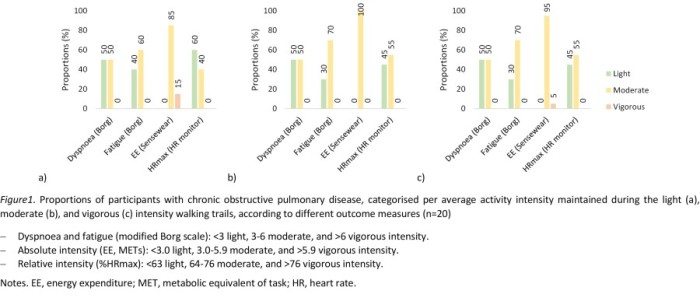Abstract
Validated walking trails are important to safely promote community-based physical activity (PA) in people with COPD. This study aimed to validate walking trails of light, moderate, and vigorous intensities in people with COPD.
This cross-sectional analysis included people with COPD who walked in a priori established trails of light, moderate and vigorous intensity. Dyspnoea and fatigue (modified Borg scale), energy expenditure (EE, Sensewear), and heart rate (HR, HR monitor) were recorded and used to classify light, moderate, and vigorous PA intensity.
Repeated-measures ANOVA or Friedman tests were used to explore quantitative differences among walking trails, and Cochran?s Q test for differences between PA intensity categories.
20 people with COPD (71±7y, 80%?, FEV1 66.1±12.2pp) were included.
Fatigue differed significantly among trails (p=0.01), with participants reporting lower scores in the light than in the moderate (2.9±1.2 vs. 3.4±1.4, p<0.01) but not in vigorous trails (3.1± 1.2). Dyspnoea (2.3±1.5 vs. 2.7±1.6 vs. 2.6±1.4, p=0.13), HR (92.48±11.06 vs. 93.72±18.36 vs. 95.36±15 bpm, p=0.63), and EE (5.07±0.80 vs. 4.93±0.48 vs. 4.64±0.78 METs, p=0.05) were similar across walking trails. In all walking trails, the intensity was considered moderate for most participants (Figure1).
Walking trails of different intensities varied mainly in perceived fatigue. People with COPD seem to adjust their physiological response to moderate intensity in all walking trails.
